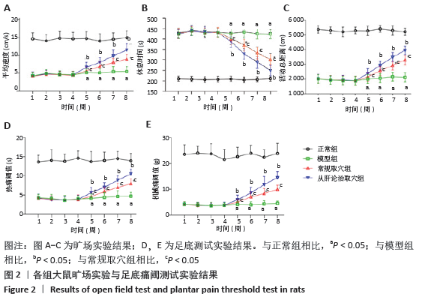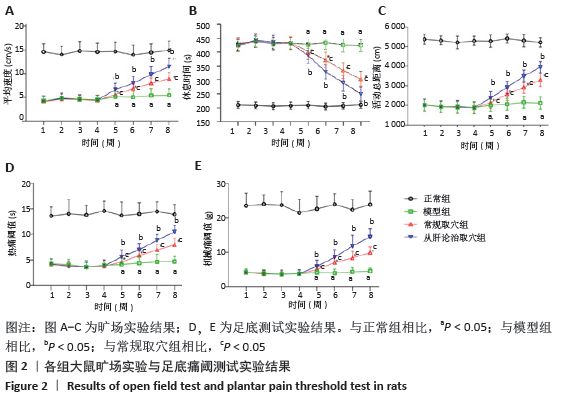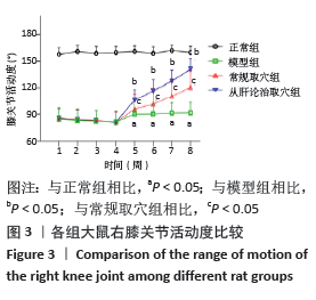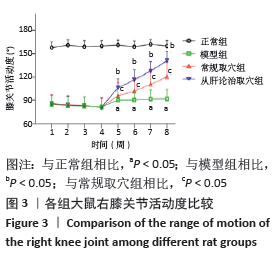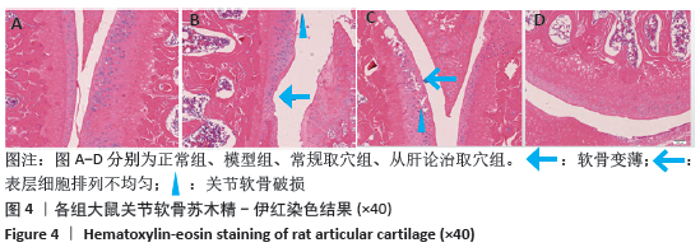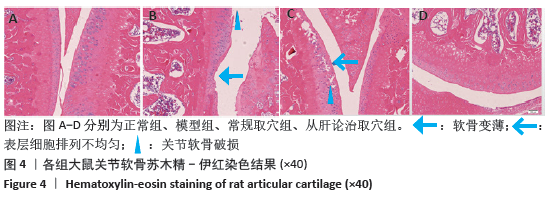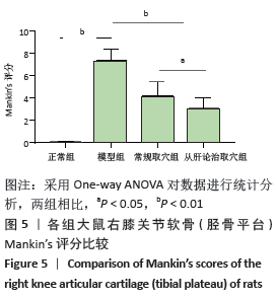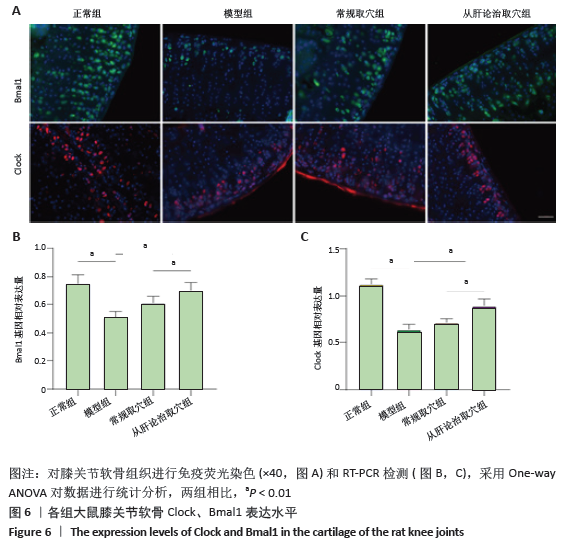[1] MARCH L, SMITH EU, HOY DG, et al. Burden of disability due to musculoskeletal MSK) disorders. Best Pract Res Clin Rheumatol. 2014; 28(3):353-366.
[2] 申延清,刘风霞,曹红,等.膝骨关节炎患者的临床表现及相关影响因素[J].中国组织工程研究与临床康复,2011,15(9):1643-1646.
[3] KC R, LI X, VOIGT RM, et al. Environmental disruption of circadian rhythm predisposes mice to osteoarthritis-like changes in knee joint. J Cell Physiol. 2015;230(9):2174-2183.
[4] GOSSAN N, BOOT-HANDFORD R, MENG QJ. Ageing and osteoarthritis: a circadian rhythm connection. Biogerontology. 2015;16(2):209-219.
[5] FISCH KM, GAMINI R, ALVAREZ-GARCIA O, et al. Identification of transcription factors responsible for dysregulated networks in human osteoarthritis cartilage by global gene expression analysis. Osteoarthritis Cartilage. 2018;26(11):1531-1538.
[6] YANG N , MENG QJ. Circadian clocks in articular cartilage and bone: a compass in the sea of matrices. J Biol Rhythms. 2016: 0748730416662748.
[7] MA Z, JIN X, QIAN Z, et al. Deletion of clock gene Bmal1 impaired the chondrocyte function due to disruption of the HIF1α-VEGF signaling pathway. Cell Cycle. 2019;18(13):1473-1489.
[8] LEE C, ETCHEGARAY JP, CAGAMPANG FR, et al. Posttranslational mechanisms regulate the mammalian circadian clock. Cell. 2001; 107(7):855-867.
[9] 王乐鹏,龙晓华,单体亮,等.肝主疏泄与人体昼夜调控机制[J].中医杂志,2015,56(7):547-550.
[10] SERT AT, SEN EI, ESMAEILZADEH S, et al. The Effects of Dextrose Prolotherapy in Symptomatic Knee Osteoarthritis: A Randomized Controlled Study. J Altern Complement Med. 2020. doi: 10.1089/acm.2019.0335.
[11] 中医骨伤科临床诊疗指南·膝痹病(膝骨关节炎)[J].康复学报,2019, 29(3):1-7.
[12] 陈婷婷,高楠.膝骨性关节炎的针灸疗法及其作用机制研究进展[J].湖南中医杂志,2019,35(7):168-171.
[13] ZHOU Y, TAO H, LI Y, et al. Berberine promotes proliferation of sodium nitroprusside-stimulated rat chondrocytes and osteoarthritic rat cartilage via Wnt/β-catenin pathway. Eur J Pharmacol. 2016;789: 109-118.
[14] 刘献祥,李西海,周江涛.改良Hulth造模法复制膝骨性关节炎的实验研究[J].中国中西医结合杂志,2005,25(12):1104-1108.
[15] KIM JE, SONG DH, KIM SH, et al. Development and characterization of various osteoarthritis models for tissue engineering. PLoS One. 2018;13(3):e0194288.
[16] 华兴邦.大鼠穴位图谱研制[J].实验动物与动物实验,1991,3(1):1-5.
[17] KUBOTA T, HIROTA K, YOSHIDA H, et al. Inhibitory effect of clonidine on ketamine-induced norepinephrine release from the medial prefrontalcortex in rats. Br J Anaesth. 1999; 83:945-947.
[18] CHAPLAN SR, BACH FW, POGREL JW, et al. Quantitative assessment of tactile allodynia in the rat paw. Neurosci Methods. 1994;53(1):55-63.
[19] 杨康栋,李发炘,梁延昌,等.双合汤对膝骨性关节炎大鼠关节液中PGE_2、MDA、SOD及MMP-3的影响[J].动物医学进展,2018, 39(7):63-66.
[20] 岳广欣,陈家旭,王竹风.肝主疏泄的生理学基础探讨[J].北京中医药大学学报,2005,(2):1-4.
[21] 王畅.电针对昼夜节律紊乱C57BL/6J小鼠肝脏Clock、Bmal1表达的研究[D].沈阳:辽宁中医药大学,2018.
[22] 王议彬.针刺调控外周组织肝内DEC1、DEC2基因表达的影响[D].沈阳:辽宁中医药大学,2018.
[23] 张权义.调肝针刺法对中老年女性膝骨性关节炎的临床疗效观察[D].广州:广州中医药大学,2017.
[24] 于阿春,苏国宏.俞原配穴治疗肝肾亏虚型膝骨性关节炎临床疗效观察[J].中医药临床杂志,2019,31(6):1127-1130.
[25] 张银娟,杨志新. “相对穴”阴陵泉与阳陵泉治疗关节疾病特异性研究概况[J].河南中医,2016,36(7):1263-1265.
[26] 刘康,田丽芳.针刺内关、太冲穴治疗膝骨性关节炎[J].中国针灸, 2013,33(2):105-108.
[27] PARTCH CL, GREEN CB, TAKAHASHI JS. Molecular architecture of the mammalian circadian clock. Trends Cell Biol. 2014;24(2):90-99.
[28] FU L, LEE CC. The circadian clock: pacemaker and tumour suppressor. Nat Rev Cancer. 2003;3(5):350-361.
[29] MATSUMOTO CS, ALMEIDA LO, GUIMARÃES D, et al. MPI3K-PTEN dysregulation leads to mTOR-driven upregulation of the core clock gene BMAL1 in normal and malignant epithelial cells. Oncotarget. 2016;7(27):42393-42407.
[30] DUDEK M, GOSSAN N, YANG N, et al. The chondrocyte clock gene Bmal1 controls cartilage homeostasis and ntegrity. J Clin Invest. 2016;126(1):365-376.
[31] BLANEY DAVIDSON EN, REMST DF, VITTERS EL, et al. Increase in ALK1/ALK5 ratio as a cause for elevated MMP-13 expression in osteoarthritis in humans and mice. J Immunol. 2009;182(12):7937-7945.
[32] GREENBLATT MB, RITTER SY, WRIGHT J, et al. NFATc1 and NFATc2 repress spontaneous osteoarthritis.Proc Natl Acad Sci U S A. 2013; 110(49):19914-19919.
[33] BUCKLAND J. Lack of Nfatc1 and Nfatc2: a new mouse model of OA. Nature Rev Rheumatol. 2014;10(1):4.
[34] BROWN SA, PAGANI L, CAJOCHEN C, et al. Systemic and cellular reflections on aging and the circadian oscillator: a mini-review. Gerontology. 2011;57(5):427-434.
[35] SHANE AA, LOESER RF. Why is osteoarthritis an age-related disease? Best Pract Res Clin Rheumatol. 2010;24(1):15-26.
[36] BELLAMY N, SOTHERN RB, CAMPBELL J. Rhythmic variations in pain perception in osteoarthritis of the knee. J Rheumatol. 1990;17(3): 364-372.
[37] 余早勤,张程亮,王友群,等.疼痛的昼夜节律与镇痛药物治疗[J].医药导报,2014,33(6):771-774.
[38] 高亮,高德.人体信息控制系统生理学[M].呼和浩特:内蒙古人民出版社,1997:1-23,151,332. |
